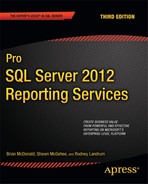Introduction
At its core, the process of designing reports hasn’t changed substantially in the past 20 years. The report designer lays out report objects, which contain data from a known source of data, in a design application such as Reporting Services, Business Objects Reports, or Microsoft Access. He or she then tests report execution, verifies the accuracy of the results, and distributes the report to the target audience.
Sure, there are enough differences between design applications to mean that the designer must become familiar with each particular environment. However, there’s enough crossover functionality to make this learning curve small. For example, the SUM function is the same in Business Objects Reports as it is in Microsoft Access as it is in Structured Query Language (SQL).
With Microsoft SQL Server 2012 Reporting Services (referred to as SSRS throughout the book), there is, again, only a marginal difference in the way reports are designed from one graphical report design application to another. So, if you do have previous reporting experience, your learning curve for SSRS should be relatively shallow. This is especially true if you come from a .NET environment, because the report designer application for SSRS 2012 is Visual Studio 2010 or the application included with SQL Server 2012, SQL Server Data Tools (SSDT), formerly known as Business Intelligence Development Studio (BIDS). We use BIDS and SSDT interchangeably throughout the book, with most references using BIDS. We have done this mainly because of the role that Reporting Services plays in the Business Intelligence stack of products with SQL Server, but also for readers who may be using prior versions of Reporting Services like SSRS 2008 R2.
Having said all this, several differences set SSRS apart from other reporting solutions:
- It provides a standard reporting platform based on Report Definition Language (RDL), which is the XML schema that dictates the common structure of all SSRS reports. This allows for report creation from any third-party application that supports the RDL schema.
- SSRS is an integral part of the SQL Server 2012 release.
- SSRS offers features out of the box that in other products would be expensive additions to a basic deployment. These features include subscription services, report caching, report history, and scheduling of report execution.
- SSRS can be extended with third party add-ons, custom code, and compiled DLL’s.
- SSRS, being a Web-based solution, can be deployed across a variety of platforms.
- SSRS also allows for easy integration with Microsoft’s Collaboration Software for the Enterprise: SharePoint 2010.
This book was written in parallel with a real SSRS deployment for a health-care application, so it covers almost every design and deployment consideration for SSRS, always from the standpoint of how to get the job done effectively. You’ll find step-by-step guides, practical tips, and best practices, along with code samples that you’ll be able to modify and use in your own SSRS applications.
Who This Book Is For
We coauthored the book with the intention of demonstrating how to use SSRS from multiple vantage points. As reporting architects and report developers, we go through the report design and deployment processes using standard SSRS tools such as Report Designer in BIDS and Report Manager. We also show how developers can extend SSRS by creating custom Windows and Web Forms applications.
Prerequisites
The core software that has been used in the examples throughout this book are:
- Microsoft SQL Server 2012
- Microsoft Visual Studio 2010 – used in chapters 7, 8, 9, and 10
- Microsoft SharePoint 2010 – used in chapter 12 with SSRS integration
- Microsoft SQL Server 2008 R2 – used in chapter 13 for ad hoc reporting using Report Models
Each of the aforementioned software is required if you, the reader, have the desire to follow along with the examples throughout the book. Most of the examples were built using SQL Server 2012, but with the exception of chapters 7, 8 and 9, they can be performed on SQL Server 2008 R2.
Downloading the Code
In this book, we use a subset of real databases designed for a health-care application that some of us developed over the years. You can find all of the supporting materials (databases, the data mart database, and cube file used in Chapter 12, the completed RDL files, queries, stored procedures, and .NET application projects, as well as full installation instructions) in the Source Code/Download section of the Apress Web site (www.apress.com). With so many other books with similar titles having existed over the years, it may be easier to find this book by using its ISBN number. The 13-digit industry standard ISBN number for this book is 978-1-4302-3810-2.
Contacting the Authors
Should you have any questions regarding any section in the book, please feel free to contact us via our email or twitter accounts. We would love to hear that you have purchased our book, so please feel free to tweet us. We sincerely hope that you get the enjoyment out of reading the book that we had in writing it for you.
Brian K. McDonald
[email protected]
@briankmcdonaldShawn McGehee
[email protected]
@SQLShawnRodney Landrum
[email protected]
@SQLBeat
